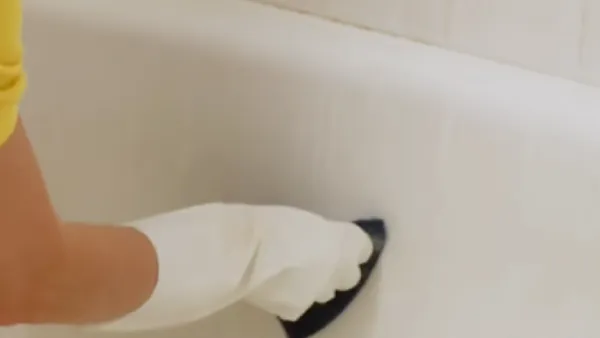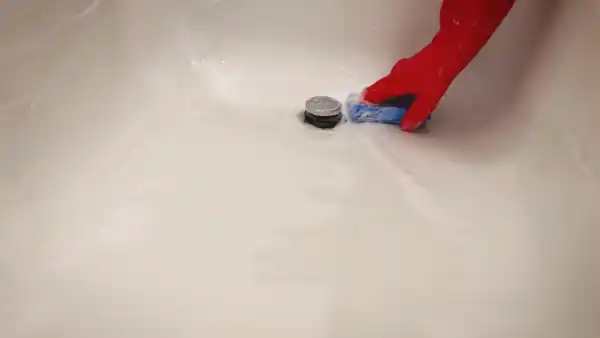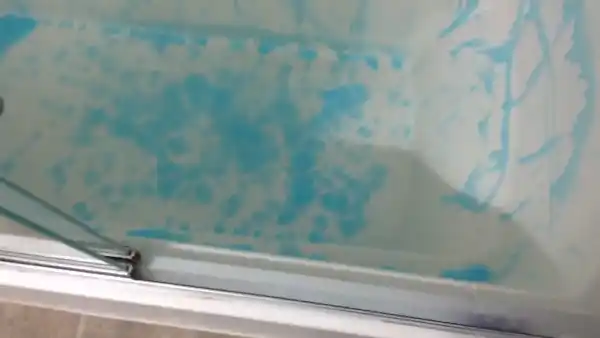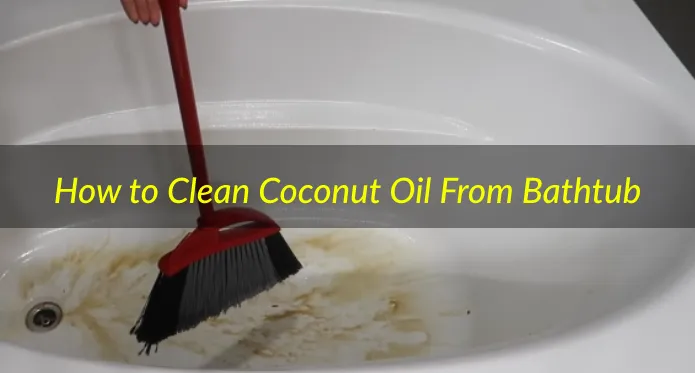Last Updated on October 16, 2023
Keep your skin hydrated without sacrificing a squeaky clean bathtub. Coconut oil is a great natural moisturizer but can often leave some sticky residue. Look no further for an easy and effective way to get rid of this mess, we have you covered in our blog post.
We’ll show you how to easily banish that greasy grime. All with the help of common kitchen ingredients.
First, prepare the area and then mix a solution of baking soda and hot water. You just need to apply the mixture onto any surface affected by oils, rinse away residue when finished, and you’re done.
So don’t miss out. Dig deeper and get all the information required now by reading on. You’ll be surprised at how simple it is to get a coconut oil-free bathtub.
How to Clean Coconut Oil From Bathtub: From Start to Finish

If you’ve ever had the unfortunate experience of coconut oil spilling onto your bathroom floor, you know it can leave behind stubborn and unsightly oil stains. But don’t fret. There are some simple techniques to get rid of this oily imprint quickly.
Here are the basic procedures to follow:
Supplies You Need:
- Baking Soda
- Hot Water
- White Vinegar (optional)
- Sponge or Scrub Brush
- Paper Towels or Absorbent Cloth
- Towel for Drying the Tub After Cleaning
Step One: Preparing the Area
Before you begin cleaning the oil off your bathtub, first make sure to remove any decorations or items that may be in the tub. Doing this now will ensure that they won’t be affected by the cleaning solutions you’re about to use.
Then use a damp cloth or sponge to wipe away any dirt or debris on the tub’s surface. Doing so will help prevent the spread of grime as you clean and prepare for Step Two.
Step Two: Creating the Cleaning Solution
Now it’s time to mix up a baking soda and water paste that will help break down and remove the coconut oil from your bathtub’s surfaces. Start by combining equal parts baking soda and boiling water in a bowl.

Begin stirring until all of the ingredients have been incorporated into a thick paste-like consistency. If you find that the stain is particularly stubborn, feel free to add some vinegar to your mixture as well. This should help further break down the tough oil residue.
Step Three: Applying the Paste To the Tub Surface
You’ll want to wear gloves or protective clothing while applying this paste to your bathtub’s surfaces. Using either a brush or sponge, apply the solution directly onto any areas of your tub where coconut oil has stained it.
Making sure to spread it out evenly over all affected areas of the tub’s walls and flooring. Gently rub in circles as you go, ensuring that every part of your tub is covered with this solution for it to work properly later on in Step Four.
Step Four: Wait For the Mixture To Do Its Work

Once you’ve applied your homemade cleaner onto all affected areas of your bathtub, leave it on for at least 10-15 minutes. So that it has enough time to penetrate through any leftover oils and loosen them up for easier scrubbing later on.
During this time frame, refrain from touching or disrupting these areas as much as possible. Allowing complete drying should give maximum results afterward.
Step Five: Rinsing Away the Residue
After waiting 10-15 minutes, it’s time to start scrubbing away at the affected area firmly with a scrubbing pad or brush. Once you’ve removed as much of the oil residue as possible, rinse the area with hot water.
You may need to repeat this process a few times until all traces of oil are gone. In the end, wipe down the entire area with a damp cloth after scrubbing is complete.
Why Should You Clean Coconut Oil From the Bathtub?
Coconut oil bath, the beloved remedy for many common ailments, has a dirty little secret. If not wiped away after use in the bathroom, it can cause severe damage over time due to its accumulative effects.

Among the reasons to clean are:
The Oil will Start to Go Rancid
This is because the oil is not being properly aerated when it’s sitting in the tub. Over time, the oil will start to turn bad and will produce an unpleasant smell. Not only is this icky, but it can also be dangerous if you accidentally ingest any of the bad oil.
It Stains Your Tub
Another problem with not cleaning coconut oil from your bathtub is that it will stain the surface. This oil is very difficult to remove once it’s been allowed to sit for a while, so if you want to keep your tub looking its best, it’s essential to clean up any spills immediately.

You’ll Attract Bugs
Coconut oil is a natural antibacterial agent, so if you don’t clean it off your tub, it will become a hotbed for bacteria. This can lead to many health problems, including skin infections, respiratory problems, and even food poisoning.
Your Tub will Become Slippery
Since coconut oil is so slippery, it can make your bathtub quite dangerous if you don’t clean it up properly. Someone could easily slip and hurt themselves if they’re not careful.
It will be Difficult to Clean Your Tub Later on
The longer you wait to clean up the coconut oil, the harder it will be to get rid of it later on. It will become caked on and much more difficult to remove, making it necessary to scrub much harder (and possibly damage your tub in the process).
How Often Should You Clean Your Bathtub If You Use Coconut Oil?
Cleaning your bathtub is an important part of bathroom maintenance, and if you use coconut oil in the bathtub, it requires more frequent cleaning. It is recommended to clean the bathtub at least once a week with a light cleanser such as dish soap or baking soda mixed with water.

Also, it’s good practice to wipe down the tub after each use of coconut oil to ensure that any residue has been removed. This will reduce the need for heavier scrubbing and cleaning later on.
Can Vinegar Clean Coconut Oil Off a Bathtub?

If you’ve used the above method for removing coconut oil from your bathtub and it wasn’t quite enough, then you can also try using some vinegar. It can help break down and loosen the oil, making it easier to remove when wiping with a cloth or sponge.
Although, it’s important not to apply vinegar directly onto the surface. Always dilute it in water first by mixing one part vinegar with two parts water in a spray bottle.
Spray the mixture liberally onto your bathtub surface and let it sit for 10-15 minutes before wiping it away with a damp cloth or soft sponge. To finish, rinse off with warm water and allow time for your bathtub surface to air dry completely before using it again.
Does WD 40 Remove Coconut Oil From the Bathtub?
Using WD-40 may be effective in removing some of the build-up caused by coconut oil. Then again, it may not be recommended for regular use as it contains chemicals that can damage surfaces over time.

As such, it must be used with caution and tested on an inconspicuous area first before applying more generously. Also, even when used properly, it may not altogether remove all traces of coconut oil from the surface, so additional cleaning methods may still need to be employed afterward.
Are Coconut Oils Safe to Flush Down the Drain?
No, coconut oil should not be flushed down the drain because when it cools, it hardens just like other cooking oils and can cause blockages in sewer systems. Aside from that, hardened coconut oil build-up can cause a clogged drain which could require professional plumbing services to resolve.

Therefore, you should never flush coconut oil down the drain directly. Instead, opt for responsible disposal methods such as pouring into a garbage bag or adding it to your compost pile.
Unlock the Secret to Effortless Coconut Oil Cleanup
Getting rid of pesky coconut oil in the bathtub doesn’t have to be a total headache. Follow these simple steps, and you can kiss that mess goodbye. Plus, with just a few extra tips, you’ll make sure it never comes back again.

Some general bathroom cleaning techniques are great for keeping your tub gleaming, so remember to give your bathroom a regular deep clean every now and then. With these few pieces of advice, you’ll be able to keep your bathtub in tip-top condition without any worry or hassle.

